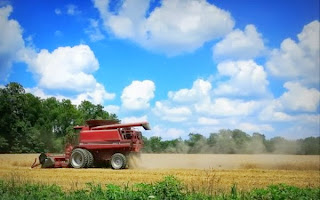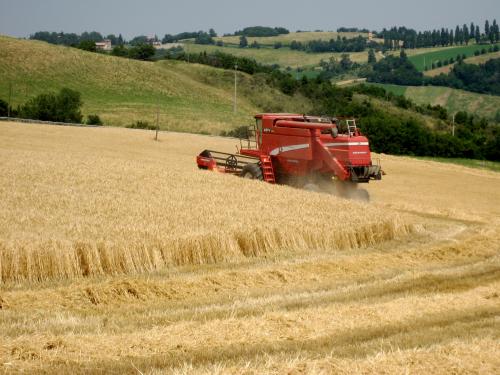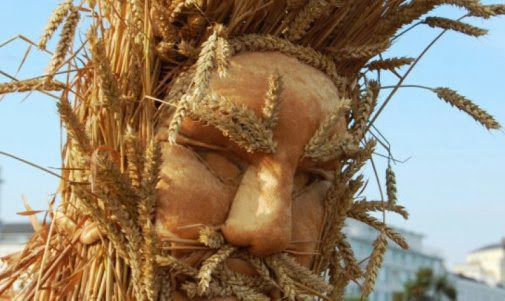Wheat harvest [Creative Commons Photo].
As of July 14, 2013, the wheat harvest around the country was progressing well.
All Aboard Wheat Harvest posted a
July 2 summary:
"Texas- Small grain harvest continued across the state. While some producers continued to graze cattle on previously damaged wheat acres, others plowed fields and prepared for fall crops. Wheat harvest was 73 percent complete.
Oklahoma- Harvest of all small grains made substantial progress. Wheat harvest was 84 percent complete by Sunday, 10 points behind the five-year average.
Colorado- Seventy-nine percent of the state’s winter wheat crop was turning color by week’s end, up from 41 percent the previous week. Twenty-two percent of the crop was ripe while 7 percent has been harvested. Condition ratings for winter wheat declined last week with the majority rated very poor to poor. Sixty-seven percent of the spring wheat was headed, compared with 64 percent last year and the average of 51 percent.
Kansas- The winter wheat crop was turning color on 98 percent of the acreage, behind 100 a year ago and 100 average. Eighty-five percent of the crop was ripe, behind 100 last year and 92 average. The crop was 57 percent harvested, well behind last year’s 99 and 67 average. Condition rated 25 percent very poor, 18 poor, 24 fair, 25 good, and 8 excellent.
Nebraska- Wheat conditions rated 24 percent very poor, 26 poor, 33 fair, 16 good, and 1 excellent. Wheat turning color was 75 percent, behind 100 last year and 82 average. Wheat ripe was 11 percent, well behind 85 last year and 28 average.
South Dakota- Winter wheat jointed was at 99 percent. Headed was at 93 percent, behind 100 last year and 96 average. Turning color was at 3 percent, well behind 95 last year and 46 average. Condition rated 28 percent very poor, 27 poor, 30 fair, 14 good, and 1 excellent. Spring wheat jointed was at 91 percent, behind 2012 at 100 but near 93 average. Headed was at 52 percent, well behind last year at 99 and 66 average. Condition rated 1 percent very poor, 4 poor, 39 fair, 46 good, and 10 excellent.
North Dakota- Spring wheat seeding was 95 percent complete, behind last year at 100 and 99 average. Emerged was 85 percent, behind last year at 100 and 98 average. Jointed was at 44 percent, behind last year at 100 and 78 average. Headed was at 7 percent, well behind last year at 79 and 29 average. Condition rated 1 percent very poor, 3 poor, 20 fair, 62 good, and 14 excellent. Durum wheat seeding was 96 percent complete, behind 100 for 2012 but near 94 average. Emerged was 83 percent, behind last year at 100 and 91 average. Jointed was at 39 percent, behind last year at 99 and 64 average. Headed was at 2 percent, behind last year at 64 and 22 average. Condition rated 0 percent very poor, 3 poor, 17 fair, 76 good, and 4 excellent.
Montana- Winter wheat is developing ahead of the 5-year average with 98 percent in boot stage and 87 percent headed. Spring wheat development is behind last year 50 percent in boot stage and 15 percent headed."
In
Michigan, winter wheat was producing at about 92 bushels an acre in Ottawa County by July 14, 2013. The photo is from Berrien County, where wheat is grown mostly for feed for livestock.
June 30, 2013 Southwest Michigan wheat field [Micki Glueckert].
In
Ohio, the July 14 yield was about 71 bushels per acre in Erie County (closest county to Ottawa County, Ohio, where the photo was taken).
June 30, 2013, winter wheat in Northwest Ohio [Betsy Slotnick].
From National Association of Wheat Growers, one
important piece of news is that South Korea has satisfied itself that U.S. wheat does not contain any genetically modified grain. This had become an issue in April when GMO wheat from Monsanto was discovered growing in an Oregon wheat field. Because Monsanto had stopped testing that strain of seed about ten years earlier, no-one had a good explanation for its presence, causing concerns that other U.S. fields could be contaminated.
The National Association of Wheat Growers also reported on national
statistics for the year to date. Bottom line: although wheat was selling in June on the commodities markets for $7.13/bushel, $.55 less than in May, the price was still $.43 better than the June 2012 market. One percent more acreage was planted in 2013 than in 2012. The winter wheat harvest was a little behind schedule this year, and the spring wheat growth was also a bit slow.
The New York Times, a week ago, picked up a Reuters piece about
the possible merger of Cargill and ConAgra wheat milling operations, that would "control about one-third of U.S. capacity, dwarfing all competitors in size and market reach." . . . Not all U.S. wheat is processed within the country of course. The U.S. Department of Agriculture estimated that "
958 million bushels of U.S. wheat will be used for food in the 2013/14 marketing year, which started on June 1, while 975 million bushels will be exported." Nonetheless, the proposed merger would give the new joint venture about one-third of the market, and leave the next largest market share in the hands of Archer Daniels Midland Co. with its current 17% of the wheat milling capacity in the U.S.
Flour mill, McConnells Mill State Park, Pennsylvania [Creative Commons Photo].
















